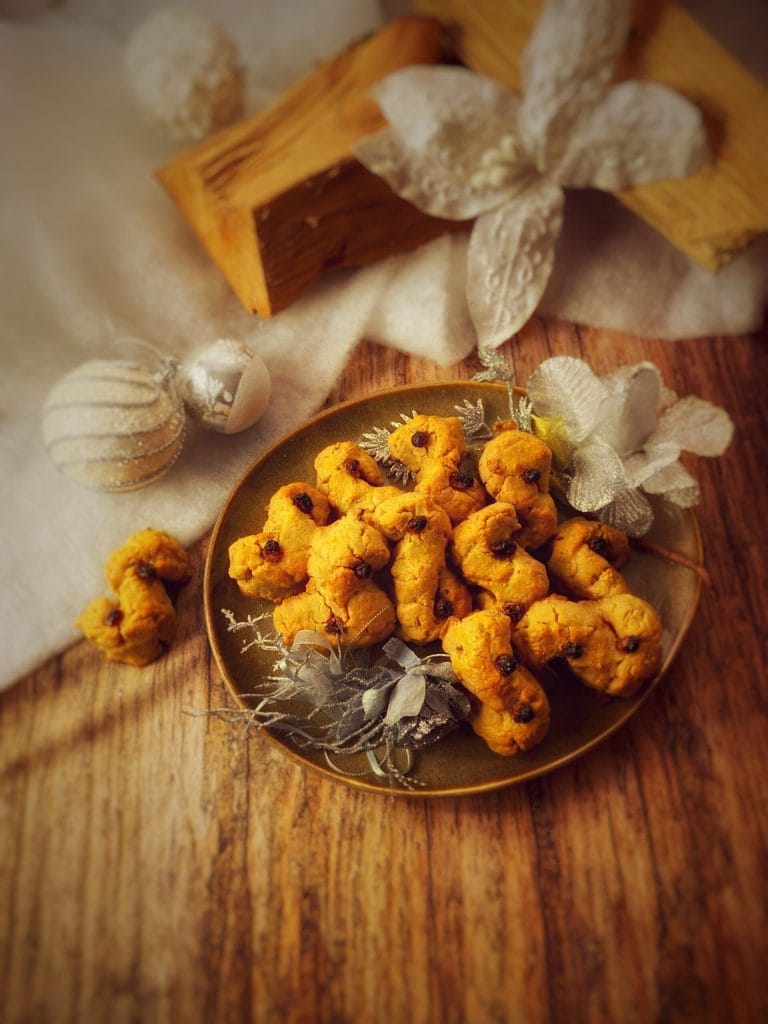Lussekatter the Swedish St. Lucia’s sweets.
▶Traditionally consumed for St. Lucia on December 13th, the lussekatter – literally: “Lucia’s cats” – also called lussebulla, lussekuse, saffransbulle, saffranskuse or julkuse, the history of their origin is rather nebulous and I invite you to read it at the end of the recipe.
▶These are Swedish buns made with saffron, usually S-shaped, but they can also have other forms.
▶▶My version of gluten-free lussekatter with rice and corn flour made them a bit more crunchy and a bit less soft.
▶In Sweden on December 13th, they are usually served by girls dressed as St. Lucia.
Here the cult of St. Lucia has been widespread since the 17th century, and every year on this occasion, girls wear a headdress decorated with candles and distribute gifts and Christmas sweets.
Not to be confused with the Cornish Saffron Buns from Cornwall, which are real buns in shape and prepared with “half and half,” meaning half milk and half cream, currants instead of raisins, and eggs among the ingredients.
Another Swedish festive sweet:

- Difficulty: Medium
- Cost: Cheap
- Rest time: 3 Hours 15 Minutes
- Preparation time: 10 Minutes
- Portions: 14 pieces
- Cooking methods: Oven
- Cuisine: Swedish
- Seasonality: Christmas
Ingredients
- 10.5 oz rice flour
- 8.8 oz corn flour
- 1.75 oz rice starch (or corn)
- 7 g gluten-free baking powder
- 1/2 teaspoon saffron
- 4.2 oz butter (melted)
- 6.3 oz sugar
- 30 raisins
- 1 pinch salt
Steps
Dissolve the yeast in 1/4 cup of warm water.
Mix the flours with the starch.
Dissolve the saffron in the milk and mix the mixture with the melted butter. Add the sugar and a pinch of salt, the flours, and the dissolved yeast.
Let rise for 1.5 hours.
From the dough, extract 15 pieces in strips, roll them on themselves, then flip and roll again to form an S.
Place 1 raisin on each curl.
Arrange on a baking sheet and let rise another 45 minutes.
Brush with beaten egg and bake in the oven at 392°F for 15 minutes.

Saffron
You can use both powdered saffron and threads.
FAQ (Questions and Answers)
What is the history of Lussekatter?
According to a legend, in 17th century Germany, the devil, in the guise of a cat, would beat children, while Jesus, in the form of a child, distributed sweets to the children.
The brightness of these sweets would ensure that the devil would retreat back into the darkness, where he actually preferred to stay.
It is believed that there is a link between the name Lucia and Lucifer due to their phonetic similarity.

